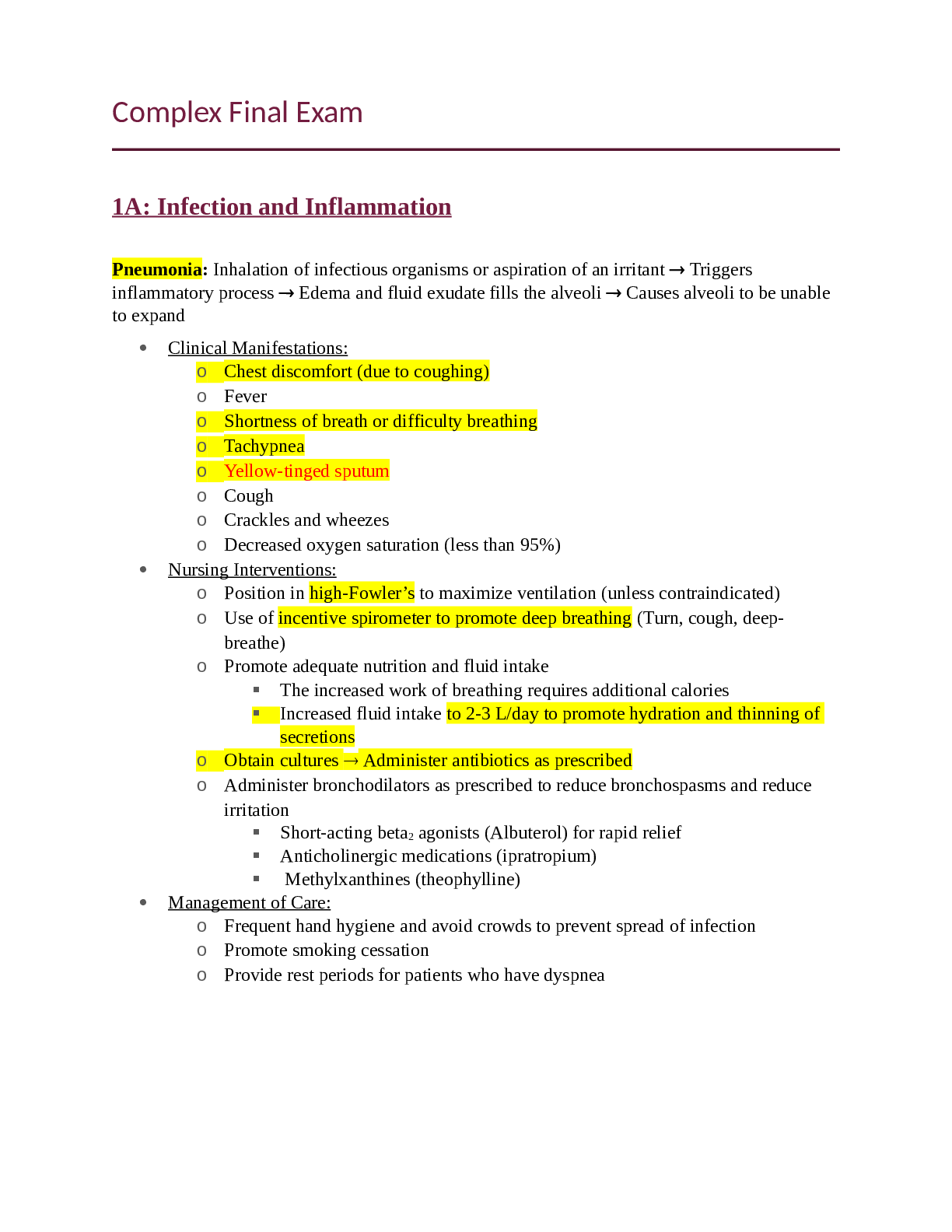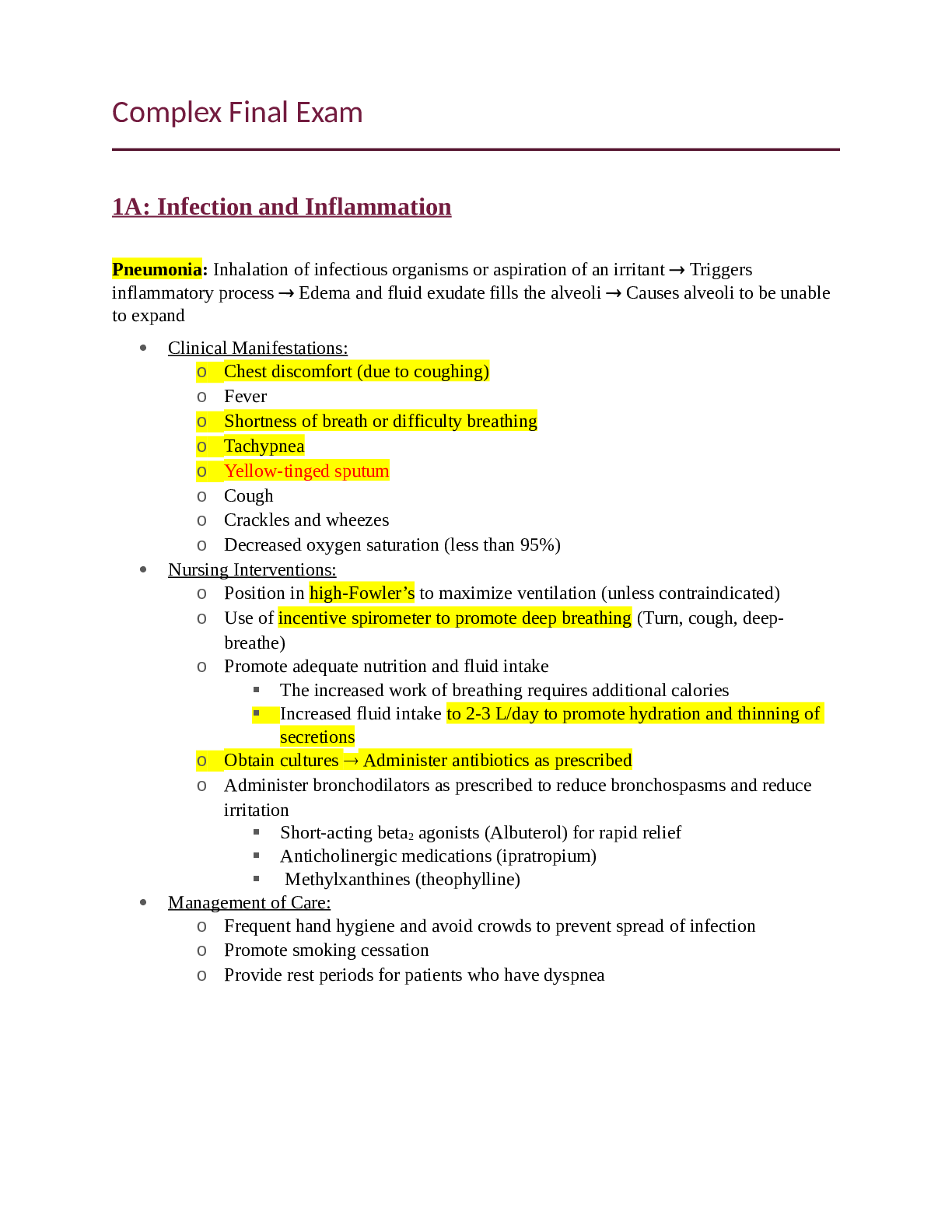1A: Infection and Inflammation
Pneumonia: Inhalation of infectious organisms or aspiration of an irritant Triggers
inflammatory process Edema and fluid exudate fills the alveoli Causes alveoli to be unable
to expand
Clinical Manifestations:
o Chest discomfort (due to coughing)
o Fever
o Shortness of breath or difficulty breathing
o Tachypnea
o Yellow-tinged sputum
o Cough
o Crackles and wheezes
o Decreased oxygen saturation (less than 95%)
Nursing Interventions:
o Position in high-Fowler’s to maximize ventilation (unless contraindicated)
o Use of incentive spirometer to promote deep breathing (Turn, cough, deepbreathe)
o Promote adequate nutrition and fluid intake
The increased work of breathing requires additional calories
Increased fluid intake to 2-3 L/day to promote hydration and thinning of
secretions
o Obtain cultures Administer antibiotics as prescribed
o Administer bronchodilators as prescribed to reduce bronchospasms and reduce
irritation
Short-acting beta2 agonists (Albuterol) for rapid relief
Anticholinergic medications (ipratropium)
Methylxanthines (theophylline)
Management of Care:
o Frequent hand hygiene and avoid crowds to prevent spread of infection
o Promote smoking cessation
o Provide rest periods for patients who have dyspnea
Tuberculosis: Infectious disease caused by Mycobacterium tuberculosis Transmitted through
aerosolization (airborne route)
Clinical Manifestations:
o Purulent sputum (possibly blood-streaked)
o Persistent cough lasting longer than 3 weeks
o Night sweats
o Low-grade fever in the afternoon
o Fatigue and lethargy
o Weight loss and anorexia
Nursing Interventions/Management of Care:
o Airborne Precautions
N95 Mask
Negative airflow room
Gloves
o Promote adequate nutrition:
Increase fluid intake to 2-3 L/day
Increase protein, iron, vitamin C, and vitamin B
o If transporting patient to another department, place a surgical mask on patient
o Sputum samples are needed every 2-4 weeks
Pts are no longer considered contagious after 3 consecutive negative
sputum cultures, and may return to work/school
o Monitor liver, kidney, vision, and hearing function while taking medications
o Apply heated and humidified oxygen as prescribed
Pharmacological Interventions:
o Combination therapy of two or more medications for 6-12 months (RIPE)
Rifampin
Will turn urine and other secretions orange (this is harmless)
Report jaundice, pain/swelling of joints, loss of appetite, or malaise
Can interfere with oral contraceptives
Isoniazid
Do not drink alcohol
Report manifestations of hepatotoxicity
Pyrazinamide
Increase fluids to help prevent kidney problems
Report jaundice, pain/swelling of joints, loss of appetite, or malaise
Ethambutol:
Complete baseline vision acuity test
Report vision changes immediately
o Emphasize that failure to take the full course of medications can lead to a resistant
strain of TB
2
Ulcerative Colitis: Inflammatory bowel disease (IBD) that causes edema and inflammation
primarily in the rectum and rectosigmoid colon
Clinical Manifestations:
o Left-lower quadrant abdominal pain/cramping uLcerative coLitis (LLQ)
o Diarrhea Up to 15-20 liquid stools/day (can contain mucus, blood, or pus)
o Rectal Bleeding
o High-pitched bowel sounds
o Abdominal distention, tenderness, and/or firmness upon palpitation
o Anorexia, weight loss, fatigue, loss of electrolytes
Management of Care:
o Monitor for electrolyte imbalances (especially potassium)
o Monitor I&O to assess for dehydration
Health Promotion/Teaching:
o Pt will need routine colonoscopies to monitor for colon cancer
o Seek emergency care for indications of bowel obstruction or perforation Fever,
severe abdominal pain, vomiting
Nutrition:
o Eat high-protein, high-calorie, and low-fiber foods
o Small, frequent meals
o Assist the patient in identifying foods that trigger manifestations
o Avoid caffeine and alcohol
o Pt may need monthly vitamin B12 injections
Crohn’s Disease: Inflammatory bowel disease (IBD) that causes inflammation and ulceration of
the GI tract; All bowel layers can become involved, with sporadic lesions
Clinical Manifestations:
o Right-lower quadrant abdominal pain/cramping
o Diarrhea 5 loose stools/day with mucus or pus
o Steatorrhea (fatty stools)
o High-pitched bowel sounds
o Abdominal distention, tenderness, and/or firmness upon palpitation
o Anorexia, weight loss, fatigue, loss of electrolytes
Management of Care:
o Monitor for electrolyte imbalances (especially potassium)
o Monitor I&O to assess for dehydration
Health Promotion/Teaching:
o Pt. will need routine colonoscopies to monitor for colon cancer
o Seek emergency care for indications of bowel obstruction or perforation Fever,
severe abdominal pain, vomiting
Nutrition:
o Eat high-protein, high-calorie, and low-fiber foods
3
o Small, frequent meals
o Assist the patient in identifying foods that trigger manifestations
o Avoid caffeine and alcohol
o Pt may need monthly vitamin B12 injections
Cholelithiasis/Cholecystitis: Cholelithiasis (gallstones) form and obstruct the cystic and/or
common bile ducts causing bile to back up in the gallbladder causing inflammation of the
gallbladder (cholecystitis)
Clinical Manifestations:
o Sharp, RUQ pain Often radiating to the right shoulder
o Intense pain with nausea and vomiting after ingestion of high-fat foods
Evidenced by increased HR, pallor, and diaphoresis
o Pain with deep inspiration during right subcostal palpation (Murphy’s sign)
o Rebound tenderness (Blumberg’s sign)
o Dyspepsia, eructation (belching), and flatulence
o Jaundice, clay-colored stools, steatorrhea, dark urine, pruritus
o Fever
Health Promotion/Teaching:
o Smoking cessation
o Lose weight if overweight/obese
o Exercise regularly
Management of Care:
o Administer analgesics as prescribed for pain
Nutrition:
o Low-fat diet, rich in HDL sources
Reduce dairy products
Avoid fried foods, chocolate, nuts, gravies
HDL sources: seafood, nuts, olive oil
o Avoid gas-forming foods (beans, cabbage, cauliflower, broccoli)
1B: Fluid and Electrolytes and Immunity
Human Immunodeficiency Virus (HIV):
Assessment:
o Stage 1 – Progression of HIV Infection:
Manifestations occur within 2-4 weeks of infection (flu-like symptoms,
rash, sore throat)
Rapid rise in HIV viral load, decreased CD4+ cells, and increased CD8
cells
o Stage 2 – Chronic Asymptomatic Infectious:
4
This stage can be prolonged and asymptomatic
The patient can remain asymptomatic for 10 years or more
o Stage 3 – AIDS:
Characterized by life-threatening opportunistic infections (Kaposi’s
sarcoma, herpes simplex virus, herpes zoster virus, candidiasis)
Diagnostics:
o Enzyme-linked Immunosorbent Assay (ELISA) Positive result indicates HIV
o Supplemental HIV antibody test (Western blot or indirect immunofluorescence
assay [IFA]) Positive result
o Pts with a positive result from ELISA, Western blot, or IFA should be tested for
viral load If CD4+ is less than 200 means it has progressed to AIDS
Management of Care:
o Highly active antiretroviral therapy (ART) – Use of 3-4 HIV medications in
combination with other antiretroviral medications to reduce medication resistance,
adverse effects, and dosages
o Main goals of drug therapy:
Decrease viral load
Maintain/raise CD4+ counts
Delay HIV related symptoms and opportunistic infections
Systemic Lupus Erythematosus (SLE): Autoimmune disorder in which an atypical immune
response results in chronic inflammation and destruction of healthy tissue; Generally
characterized by periods of exacerbations and remissions; Can lead to lupus nephritis (leading
cause of death for SLE)
Read More


